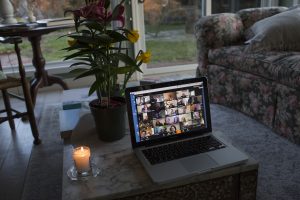Tazria – Metzora – Covid 19 2020: The Zoom Room
by devadmin | April 22, 2020 8:15 pm
Raboyseyee and Ladies:
We begin with some givaldige news. As the Oisvorfer is putting the finishes touches of this week’s posting, he is zoomed into the wedding of Daniel Stroh who will –as soon as the kallah stops circling him – be marrying his beautiful bride Miriam Wilson, she the daughter of Devorah and Nosson (Ken) Wilson. What a great moment for all to see during these otherwise dark days.
A big hearty mazel-tov to our friends Donna and Ed Stroh on this great occasion and simcha. Mazel tov to the Stroh and Wilson extended families. May Miriam and Daniel be zoiche to enjoy many decades of beautiful and blissful marriage. We look forward to dancing with you at the appropriate time and to sharing many other simchas in our respective families.
The Zoom Room:
Back in the year 2448 and days before the RBSO redeemed His about to be Chosen People from slavery, He gave them very specific instructions about remaining isolated indoors. He was personally going to visit the plague of the first born upon the Mitzrim. The Jewish people were not to leave their houses. Though Pesach is indeed in our rear view mirrors, let us go back to Parshas Boi where we read these words.
| 21. Moishe summoned all the elders of Yisrael and said to them, “Draw forth or buy for yourselves sheep for your families and slaughter the Pesach sacrifice. | כאוַיִּקְרָ֥א משֶׁ֛ה לְכָל־זִקְנֵ֥י יִשְׂרָאֵ֖ל וַיֹּ֣אמֶר אֲלֵהֶ֑ם מִֽשְׁכ֗וּ וּקְח֨וּ לָכֶ֥ם צֹ֛אן לְמִשְׁפְּחֹֽתֵיכֶ֖ם וְשַֽׁחֲט֥וּ הַפָּֽסַח: | |
| 22. And you shall take a bunch of hyssop and immerse [it] in the blood that is in the basin, and you shall extend to the lintel and to the two doorposts the blood that is in the basin, and you shall not leave the entrance of your houses until the morning. | כבוּלְקַחְתֶּ֞ם אֲגֻדַּ֣ת אֵז֗וֹב וּטְבַלְתֶּם֘ בַּדָּ֣ם אֲשֶׁר־בַּסַּף֒ וְהִגַּעְתֶּ֤ם אֶל־הַמַּשְׁקוֹף֙ וְאֶל־שְׁתֵּ֣י הַמְּזוּזֹ֔ת מִן־הַדָּ֖ם אֲשֶׁ֣ר בַּסָּ֑ף וְאַתֶּ֗ם לֹ֥א תֵֽצְא֛וּ אִ֥ישׁ מִפֶּֽתַח־בֵּית֖וֹ עַד־בֹּֽקֶר: | |
| 23. The Lord will pass to smite the Egyptians, and He will see the blood on the lintel and on the two doorposts, and the Lord will pass over the entrance, and He will not permit the destroyer to enter your houses to smite [you]. | כגוְעָבַ֣ר יְהֹוָה֘ לִנְגֹּ֣ף אֶת־מִצְרַ֒יִם֒ וְרָאָ֤ה אֶת־הַדָּם֙ עַל־הַמַּשְׁק֔וֹף וְעַ֖ל שְׁתֵּ֣י הַמְּזוּזֹ֑ת וּפָסַ֤ח יְהֹוָה֙ עַל־הַפֶּ֔תַח וְלֹ֤א יִתֵּן֙ הַמַּשְׁחִ֔ית לָבֹ֥א אֶל־בָּֽתֵּיכֶ֖ם לִנְגֹּֽף: |
Let us focus in on these few words, “…and as for you, you shall not leave the entrance of your houses until the morning.” Rashi wondering why the Yiddin were locked in for the evening says azoy: “once the RBSO gave permission to the angel of death to cause damage (kill people), the destructor does not differentiate between the righteous and the wicked.” Yikes!
In the year 5880, the Malach Hamoves (the angel of death) is again on the loose and must be stopped. What his specific mission is, ver veyst, ober daily, if not twice or thrice daily, emails are being sent from various shuls announcing with sorrow the passing of yet more individuals. In the yeshiva world, there are at least three sites where one can find the long -and growing daily- list of the deceased. The list of mourners is much much longer. And it’s all very sad; tragic a better descriptor of what’s going on. Thousands of families are losing members, leaving behind multiple times those numbers in orphans. Yikes!
And this week, instead of reviewing Parshas Tazria and Metzora both of which we will “not” be read this coming shabbis as the shuls and all else remain in a state of lockdown, we will instead focus on two subjects on the Oisvorfer’s mind. Ironically both parshas discuss the ‘metzora,’ a person –male of female- afflicted with tozra’as, some form of skin condition which at one time was associated with leprosy. What is it today? Ver veyst? In any event, it seems to have disappeared. Moreover, the parsha tells us just who is charged with diagnosing the disease, declaring the afflicted person as a metzora, and then issuing orders for sequestration. Two bottom lines: Ershtens, the RBSO empowered the kohanim (priests) though not medically trained to diagnose and then send the afflicted into quarantine. Secondly: how many times has the Oisvorfer told you in the past nine and one half years, azoy: all that goes on in the world today is rooted and discussed in the heylige Toirah? And if not there, zicher in the heylige Gemora. Many!
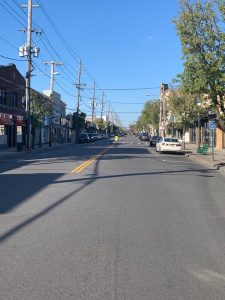 In the year 5880, we are all sequestered; we remain in quarantine waiting for the ‘all clear’ sigh before we move about, and out of the cabin. What is there to do when quarantined? What to do when one had shoulder surgery but five weeks back and cannot yet exercise? Walk! And walking is one activity the Ois has been enjoying just about daily. Sometimes alone, sometimes accompanied by the eishes chayil, but mostly accompanied by one of his daughters (Alex who is back from LA during this pandemic). We have been walking many miles together. A typical walk is five or more miles. Though we try changing up the route from time to time, invariably, as creatures of habit, we wind up on the shopping strip which is lined with various stores and food establishments.
In the year 5880, we are all sequestered; we remain in quarantine waiting for the ‘all clear’ sigh before we move about, and out of the cabin. What is there to do when quarantined? What to do when one had shoulder surgery but five weeks back and cannot yet exercise? Walk! And walking is one activity the Ois has been enjoying just about daily. Sometimes alone, sometimes accompanied by the eishes chayil, but mostly accompanied by one of his daughters (Alex who is back from LA during this pandemic). We have been walking many miles together. A typical walk is five or more miles. Though we try changing up the route from time to time, invariably, as creatures of habit, we wind up on the shopping strip which is lined with various stores and food establishments.
 Here in the Five Towns, stores line sections of Cedarhurst and Lawrence and where Central Avenue goes residential, we may make our way over to Broadway where sections of Woodmere and Hewlett too are lined with stores. What have they all in common? They are all closed. Why we choose to pass the same closed stores daily, ver veyst? While discussing the insanity of the repetitive route, Alex pointed out that none of the windows displays had changed in weeks. And that got the Oisvorfer thinking azoy: should storeowners –while forced to remain closed- have an obligation to change their window displays for the benefit of us pedestrians? Are we not sick and tired of looking at the same displays? We are! This is a givaldige opportunity for store owners to get creative and makes their stores inviting. Veyter!
Here in the Five Towns, stores line sections of Cedarhurst and Lawrence and where Central Avenue goes residential, we may make our way over to Broadway where sections of Woodmere and Hewlett too are lined with stores. What have they all in common? They are all closed. Why we choose to pass the same closed stores daily, ver veyst? While discussing the insanity of the repetitive route, Alex pointed out that none of the windows displays had changed in weeks. And that got the Oisvorfer thinking azoy: should storeowners –while forced to remain closed- have an obligation to change their window displays for the benefit of us pedestrians? Are we not sick and tired of looking at the same displays? We are! This is a givaldige opportunity for store owners to get creative and makes their stores inviting. Veyter!
The untimely passing of so many has left – as mentioned above- thousands of orphans, male and female. In orthodox circles, male children of every age are required to recite Kaddish Yosom (the mourner’s kaddish) for eleven months post burial, and it’s this kaddish that’s on my mind this week. In fact, it’s deserving of a shtikel rant. It’s on my mind because I am feeling very badly for all those who –due to corona and closed shuls- cannot recite this particular kaddish. They are being cheated and damaged.
And before we get into specifics, let us review some background on the mourner’s kaddish prayer. What is it? Why is it recited? Is its recitation biblically commanded? Is it mentioned anywhere in the heylige Gemora? Shoin, after consulting various sources including rabbis, medrish, the heylige Gemora, and the great “Google Hador,” (pun intended) here are a few facts.
What we know: developed only in the Middle Ages, Kaddish is a prayer whose recitation, over time, became the obligation of mourners. This recitation is neither commanded nor mentioned anywhere in the heylige Toirah. Moreover it is also not a rabbinic mitzvah. Oib azoy (if that’s so), what is it? Seemingly, it is a strongly held custom. In fact, the mourner’s kaddish is rooted –believe it or not, ober it’s emes- in a medrish which records a myseh (story) of Rebbe Akiva and the kaddish. Interestingly enough and efsher chock full of irony, the Yiddin would end up mourning for the many students (thousands) who perished between Pesach and Lag Bo’oimer. The mourner’s Kaddish differs slightly and more from other kaddish prayers (there are five different forms of kaddish in total), is not mentioned in the heylige Gemora, or even in the Shulchan Aruch. Nu, since you forgot, here they are: the half kaddish, the full kaddish, the rabbis kaddish, a kaddish recited at the cemetery, and the mourner’s kaddish. We should also include yet another version recited when making a sium (completing a tractate of the heylige Gemora.
Who invented the kaddish and how did it become the custom and the one quintessential payer recited by mourners? Of course that depends on whom you ask but the bottom line is this: in Jewish law, the Mourner’s Kaddish is almost non-existent. It ranks low in the hierarchy of halocho. That being said, in everyday religious life, Kaddish ranks very high in the priorities of the people who say it. This is why cancelling Kaddish causes great pain to a mourner’s deep and intimate world.
It’s universally accepted that mourners –especially the males- recite mourner’s kaddish. Over time, the custom developed for a man (and, more recently, a woman) who has lost a parent to say Kaddish for 11 months. What? Women reciting kaddish!? Say it’s not so and certainly a woman reciting the kaddish was unheard of when the future Ois was growing up. Ober, in hyntige tzeytin (in today’s times), it appears there is evidence of some women saying the Mourner’s Kaddish for their parents at the grave, during shiva, and in daily prayers since the 17th century. Slowly but surely it’s become acceptable. Why not? Did they not lose a parent? Shoin!
Though the kaddish was likely not written to console the mourners –it was in fact written for the exhalation of the RBSO, having –back in 2004 and 2005 recited kaddish for twenty consecutive months (having lost both parents in nine months), the heylige Ois found his thrice daily recitations of the kaddish meaningful and fulfilling.
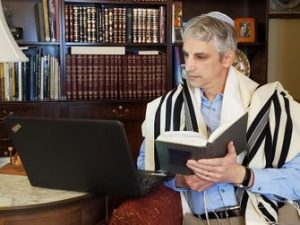 All this brings us to the year 5880 or 2020 when shuls are closed. The current quarantine has many facets to it and fallout aplenty. One aspect is the loss of the daily experience of gathering as a community for prayer. In corona times, those accustomed to davening (praying) with a minyan (a prayer quorum of 10 men, for the purpose of this discussion), whether once, twice, or three times a day, feels a deep break in their routines. And that’s just us regular shul-goers. Imagine the loss being felt by those obligated to recite the Kaddish Yosom (mourner’s kaddish). During ordinary times, mourners go to extreme lengths to arrange their entire schedule in a way that will ensure that they do not miss saying Kaddish. Daily schedules, business meetings, as well as travel and vacations are all centered around the kaddish. Where is the closest shul? What time is davening? In fact, to many of the kaddish-zugers (person reciting the kaddish), being in shul to recite the kaddish is the only reason they are present. Even those unaccustomed to davening (with or without a minyan), make it their business to be in shul for kaddish. Why? Mysteriously, the Kaddish has a magical pull, a power over those reciting it. And for those reasons and many more, each person reciting the kaddish may have their own unique kaddish experience. The kaddish has power!
All this brings us to the year 5880 or 2020 when shuls are closed. The current quarantine has many facets to it and fallout aplenty. One aspect is the loss of the daily experience of gathering as a community for prayer. In corona times, those accustomed to davening (praying) with a minyan (a prayer quorum of 10 men, for the purpose of this discussion), whether once, twice, or three times a day, feels a deep break in their routines. And that’s just us regular shul-goers. Imagine the loss being felt by those obligated to recite the Kaddish Yosom (mourner’s kaddish). During ordinary times, mourners go to extreme lengths to arrange their entire schedule in a way that will ensure that they do not miss saying Kaddish. Daily schedules, business meetings, as well as travel and vacations are all centered around the kaddish. Where is the closest shul? What time is davening? In fact, to many of the kaddish-zugers (person reciting the kaddish), being in shul to recite the kaddish is the only reason they are present. Even those unaccustomed to davening (with or without a minyan), make it their business to be in shul for kaddish. Why? Mysteriously, the Kaddish has a magical pull, a power over those reciting it. And for those reasons and many more, each person reciting the kaddish may have their own unique kaddish experience. The kaddish has power!
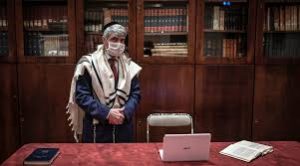 Until we get our shuls back, those who lost a parent find it impossible to recite the kaddish. Says the Oisvorfer azoy: the mourners are being cheated. As well, they are being psychologically tormented. Many are, and will remain guilt ridden for weeks, months and some, forever. In addition to the profound sadness over their respective losses, why should they also be bereft of the soothing and fulfilling recitation of the mourner’s kaddish? Is there a solution?
Until we get our shuls back, those who lost a parent find it impossible to recite the kaddish. Says the Oisvorfer azoy: the mourners are being cheated. As well, they are being psychologically tormented. Many are, and will remain guilt ridden for weeks, months and some, forever. In addition to the profound sadness over their respective losses, why should they also be bereft of the soothing and fulfilling recitation of the mourner’s kaddish? Is there a solution?
Avada we all chap that shuls must remain closed, ober, are there not other ways for mourners to recite the kaddish? Earlier this morning, the Ois was on the phone with a chaver who resides in the Satmar Chasidic community of Monroe, New York. While discussing kaddish during corona times, he told me azoy: a gentleman on his block is saying kaddish. What to do? At the appointed time, several neighbors go out to onto their terraces and or open their windows and then stick their heads out. The gentleman recites the kaddish to a minyan, they answer responsively where indicated and shoin. In an area where most everything in the world is verboten, their rebbe has advised that each of them can –in their own way- be mitztarafe (included) in the necessary quorum. The bottom line: though not in shul and in one room, they found a way for the mourner to recite kaddish.
Grada it’s not that simple as the discussions of where and under what conditions the kaddish may be recited is long and hotly debated. And the bottom line of these arguments is azoy: Kaddish must be recited with a minyan (a quorum of ten people). As well kaddish must be seemingly be recited in one room without a wall. In other words, ten people must be assembled in one room for the kaddish-zugger (person reciting the kaddish) to have a proper quorum. Again, the very specifics of these rulings is above the Oisvorfer’s pay grade; he does not make halachic rulings unless of course someone drops a pair of interhoizen (underwear) for inspection, if you chap.
That being said, the Oisvorfer is left wondering azoy: why haven’t the rabbis found a way to have the kaddish saying members of their respective communities to recite the kaddish? At least once a day? Instead they are told to recite some extra Tihilim and or to give some extra charity? Does this really cut it? Does this really help the mourner? In a year where rabbis all over the world, including some with marquee names- have found ways for us to make Pesach without burning chomatze –suddenly it’s ok to break down the pieces and flush them down the toilet, have a seder –or even both- over zoom and Facetime, not found their creative juices and facilitated kaddish to be recited? Chumras (imposed restrictions) that have been around for decades, disappeared with the arrival of corona. Why not have ten cars assemble side by side or in an open field where each can pop their heads out their respective sun roofs to listen to a kaddish? Why not have kaddish on the block of a mourner with adequate social distancing? Why not a quick pop-up kaddish while food shopping? Men are shopping! Attention shoppers: Kaddish now being recited in aisle 5! Let’s get creative.
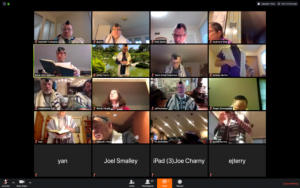 Mindful of the importance of tifilah bitzibur (davening with a minyan) in these corona times and with shuls closed, our rabbis have -in some ways -gotten creative. Locally at least one rabbi has facilitated assembled davening through the very creative “davening at the same time over zoom” initiative. People enter the zoom through zoom at the set time and shoin: a virtual davening takes place. Ober, in order to comply with halachic rulings they omit the three items referred to as “dovor shebikedusha” as those require a physical minyan. So happens that while davening at the same time and when hearing the brochos (blessings) being recited, we reflexively –from the comfort of our own homes but in the zoom room- answer with omen where appropriate. We do so because it’s what we do; it’s how we are programmed.
Mindful of the importance of tifilah bitzibur (davening with a minyan) in these corona times and with shuls closed, our rabbis have -in some ways -gotten creative. Locally at least one rabbi has facilitated assembled davening through the very creative “davening at the same time over zoom” initiative. People enter the zoom through zoom at the set time and shoin: a virtual davening takes place. Ober, in order to comply with halachic rulings they omit the three items referred to as “dovor shebikedusha” as those require a physical minyan. So happens that while davening at the same time and when hearing the brochos (blessings) being recited, we reflexively –from the comfort of our own homes but in the zoom room- answer with omen where appropriate. We do so because it’s what we do; it’s how we are programmed.
And we close with this: Avada we are all aware that pikuach nefeh is doiche all. In plain English: we all know that the saving of lives –even one- pushes away any and all restrictions. For those reasons Hatzola members carry radios and are permitted to drive on shabbis. For pikuach nefesh, we allow certain individuals to eat on Yom Kippur. And avada our rabbis are also aware that pikuach nifoshos is not limited to a threat on physical life; our rabbis long ago concluded that pikuach nifoshis also extends and includes psychological trauma. It is the reason that certain well respected rabbis have allowed abortion -otherwise verboten by Jewish law- in certain cases. Bottom line: where there is will, there can be a kaddish. Those obligated in kaddish need and should have a way found.
While kaddish in the zoom room will seemingly not be approved by all rabbis –what in our religion is?- it so happens that at least one well respected rabbi out of Israel understands well the trauma to those who are required to say kaddish and cannot. In an article written by Rabbi Dr. Benjamin “Benny” Lau and featured in the Times of Israel, the Oisvorfer found this which he quotes verbatim below. Said Rabbi Eliezer Melamed, he the rosh yeshiva of Yeshivat Har Bracha and author of the series Peninei Halakha, azoy regarding guidelines for conducting a Zoom prayer service in accordance with Jewish law.
- All of the below is intended for those who want to take the extra step of praying in a minyan. According to Jewish law, though, at a time when it is difficult to pray in a minyan, one may pray individually at the outset.
- Due to questions regarding the exact definition of the terms “makom” (place) and “kol” (voice) in the context of communal prayer, it is impossible to define a group of people who have gathered for a virtual service via Zoom as a quorum of 10 for any of the prayers that are considered to be “dvarim shebikdusha” that require a minyan.
- The recitation of the Mourner’s Kaddish (Kaddish Yatom) and of the Rabbi’s Kaddish (Kaddish d’Rabanan) is not considered to be a recitation of a “blessing in vain” (“bracha l’vatala”). Therefore, a virtual meet up can be considered a kind of minyan for the recitation of these prayers.
- In a time of great need, when there is value for the entire community to pray together virtually, reciting “Barchu” before the recitation of the blessings leading up to the Shema is not considered to be a “blessing in vain.” It is therefore permissible to say Barchu at a virtual prayer service.
- In Jerusalem, it is customary to say the “Tachanun” prayer even when praying alone, not only in the presence of a minyan. In other places, Tachanun is recited by a sole worshiper if there are holy books in the place of prayer. According to Rabbi Melamed, a meeting via Zoom can be considered to be a place with holy books, and Tachanun can therefore be recited even if the prayer service is not considered to be a minyan.
- If there is a prayer leader who can recite the “13 Attributes of Mercy” out loud for the community, singing them in the Torah trop (cantillation) of those verses in the Torah, the community may recite the 13 attributes together with the prayer leader.
A very prominent rabbi with whom I had a rather lengthy conversation with just last night reminded me of the words of Reb Chaim Brisker. In response to a question on why he was being maykil (lenient) on a case involving eating on Yom Kippur, he answered azoy: “I’m not being maykil on fasting, I’m being strict on pikuach nefesh.” Shoin, I feel better; how about you?
A gittin Choidesh Iyar and a gittin Shabbis!
The Heylige Oisvorfer Ruv
Yitz Grossman
Source URL: https://oisvorfer.com/tazria-metzora-covid-19-2020-the-zoom-room/
